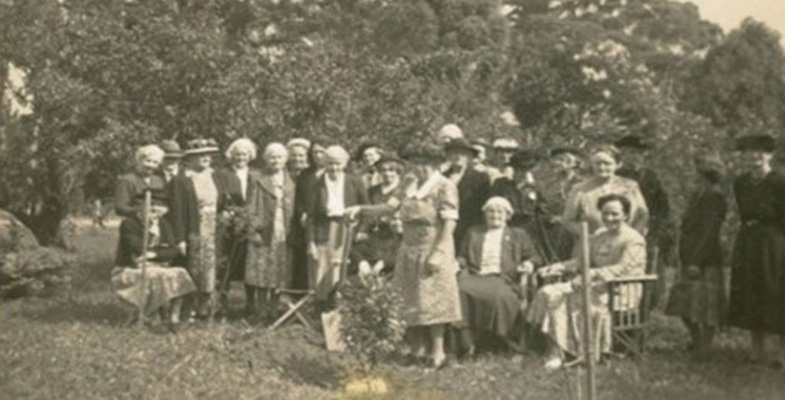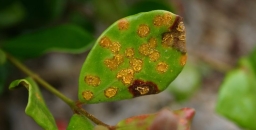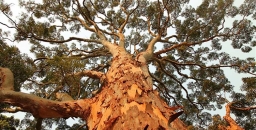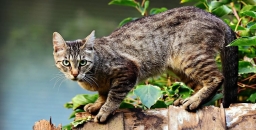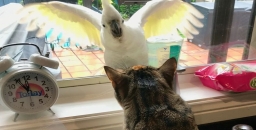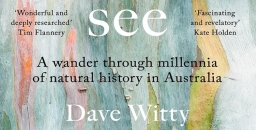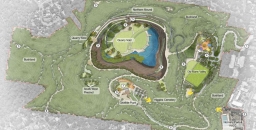Ku-ring-gai has a rich environmental history. Some even consider it to be the birthplace of the Australian conservation movement because it was here that one resident, Annie Forsyth Wyatt, called for a National Trust (NSW) to be founded.
Gordon resident, Annie Wyatt (1885–1961) became a strong force in the emerging conservation movement, collaborating with many other key Sydney conservationists of the 1930s. Annie Wyatt was very insistent that the early National Trust (NSW) be a force in protecting the natural environment:
… to safeguard and govern the national state parks, national monuments and reserves of the state.
Annie Wyatt, grew up when there was deep concern about the loss of many of Australia’s forests. As a young woman she witnessed the ‘wanton destruction’ of the trees, bushlands, forests, woodlands and fine colonial houses on Sydney’s Cumberland Plain, when she lived at Rooty Hill as a young girl.
However, Annie Wyatt became a conservationist ‘activist’ after being incensed when she saw a Ku-ring-gai Council truck dumping garbage into the creek below her home in Gordon in 1927. Distressed, she quickly gathered her neighbours together.
This led to her forming the Ku-ring-gai Tree Lovers’ Civic League which aimed ‘to safeguard the natural charms of the municipality’ and in particular to promote Australian native trees.
The League organised school essay competitions and tree planting ceremonies that included celebrating ‘tree lover’ Joseph Maiden (1859–1925), the Director of the Botanical Gardens and a pioneer advocate for eucalyptus forests.
Underneath the magnificent lemon-scented gum tree along Henry Street, Gordon, in the Annie Wyatt Park, next to Gordon Station, lies a plaque dedicated to Mr and Mrs Charles Musson. The Ku-ring-gai Tree Lovers’ Civic League planted this eucalyptus in memory of Charles Musson (1856–1928), Gordon resident and teacher-lecturer at the Hawkesbury Agricultural College. Charles Musson was a great enthusiast for the new school subject – nature study – that was being introduced into the school curriculum in the early 20th century.
The Ku-ring-gai Tree Lovers’ Civic League inspired others to form their own tree lovers’ leagues in places such as Lane Cove, Mosman and Orange.
Annie Wyatt and the Ku-ring-gai Tree Lovers’ Civic League, went on to work with many other conservationists in the 1930s including Charles Bean (1879-1968), revered WW I war correspondent and historian, and founder of the Parks and Playground Movement. Charles Bean was active in promoting the green-belt around Sydney with parks and playgrounds including the Lane Cove and Garigal National Parks (former Davidson).
David G Stead (1877–1957), the founder of one of the first organisations to protect native wildlife (the Wildlife Preservation Society) in 1909, was supportive of Annie Wyatt’s motion to form the National Trust at the Save the Trees Conference in 1944. This conference arose from the deep concern about the massive clearing of forests happening across the country.
Annie’s son Ivor Wyatt (1915-2004) followed his mother’s conservation efforts, and became president of the National Trust working with David G. Stead’s wife, botanist and teacher-lecturer Thistle Y Harris (1902–90), to promote the flora and fauna sanctuary and environmental education centre – Wirrimbirra – at Bargo.
Annie Wyatt, was an unashamed ‘ardent tree lover’. She rejected the notion of ‘progress’ that emerged as the dominant ethos after WW II that demolished swaths of colonial buildings and land cleared massive bushland across the state.
When Annie Wyatt formed the National Trust of NSW in 1945 she wanted an organisation that would protect monuments, houses and landscapes for perpetuity. She modelled it on the English National Trust which was fighting to protect its own significant buildings, monuments and landscapes from being destroyed by encroaching industrialisation towards the end of the 19th century.
The National Trust became an important counter voice opposing the post war calls for modernity and ‘progress’ that was knocking down so much history and nature.
When Annie Wyatt saw the threat to the Dalrymple Hay Forest on Mona Vale Road, Pymble/St Ives in 1934 she worked with the ‘tree mayor of Ku-ring-gai’, Cresswell O'Reilly (1877–1954) to raise funds to purchase 11.5 acres to prevent the subdivision of Dalrymple Hay Forest, Mona Vale Road, St Ives in 1934. Cresswell O’Reilly would go on the chair the first meetings of the National Trust of Australia (NSW) formed in 1945.
Professor Eben Gowrie Waterhouse (1881–1977), of Eryldene, Gordon, also supported Annie Wyatt in this Ku-ring-gai forest campaign and presented the petition to save the Blue Gum High Forest to Ku-ring-gai Council. The community was again galvanised into campaigning to protect this unique and precious forest when it was again threatened with development from 2004–07.
Annie Wyatt’s conservation ethic continues to this day in the fight to protect Sydney’s urban bushland.
Photo at the top of the page is of the Tree Lovers’ Civic League planting in 1949 (courtesy National Trust of Australia (NSW) Archives)
Janine Kitson

